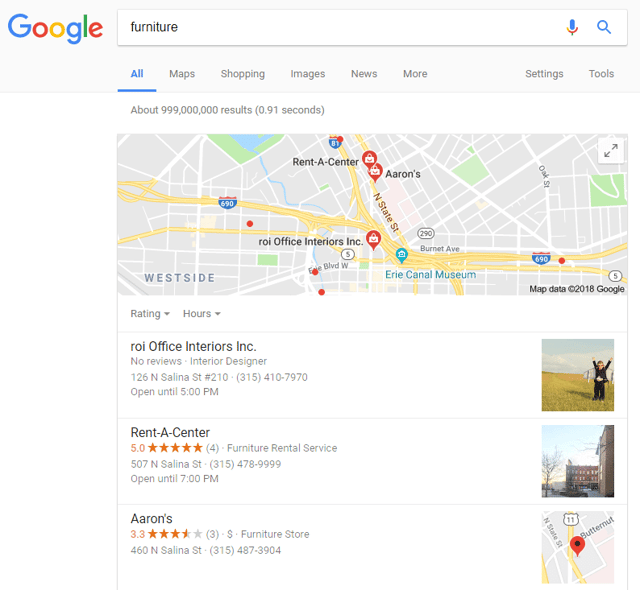Arguably the most important thing to consider during the content development process is how Google will treat your work. And in order to create posts that are seen favorably by Google and therefore placed high on the search engine results page (SERP), you have to follow search engine optimization (SEO) best practices.
Google makes this challenging, however, by regularly implementing changes that alter not only how the SERP looks, but which content actually appears there.

This is a lengthy subject, so we’ve created a two-part guide concerning the crucial SERP changes every business blogger needs to take into consideration with their SEO content writing. Here, in the first volume, we’ll summarize some of these changes, while next week’s edition will explain the actions your business should take to handle them.
1. RankBrain has revolutionized SEO content writing.
RankBrain is a complex topic in itself, but we’ll keep it short. RankBrain is one of many signals that Google employs to determine the results on any search query. It’s a machine learning system that proactively learns as it works, and it’s designed to interpret queries on a more complex level than the standard mathematical algorithm. This means that it’s often capable of extracting the intention of a query, even if the searcher wasn’t precise.
This simultaneously toughens things for bloggers while also making keyword practices more flexible. The difficulty stems from the fact that results that might not contain the specific query can still rank if they’re optimized for similar keywords – for example, by using “buying articles” instead of “buy articles.” But on the other hand, writers now have the ability to change up their keywords in the same vein, allowing more fluid integration of keywords in general.
2. Featured snippets highlight the importance of SEO-friendly content writing services.
Have you asked Google a question lately? Give it a try, and you’ll probably find the answer in a blurb at the top of the SERP. These blurbs are known as featured snippets, and they replace the usual top result by attempting to provide your query with a specific answer. It’s a technology that’s not yet been perfected, but it certainly has its uses.

This holds especially true when it comes to voice searches, which are often conducted while users don't have a free hand to type on their phones. Browsers can now simply ask their virtual assistant a question, and the assistant sends that question to Google. Once the search is complete, the user will be rewarded with a voiced answer courtesy of the featured snippet. In addition to being convenient for those using Google, this also adds a unique element of competition to the SEO content writing world.
3. Related questions ramp up SEO content writing competition.
Related questions and featured snippets go hand in hand. Consider the question you asked Google when we discussed featured snippets. Did you notice a block below the featured snippet with the heading “People also ask” and an assortment of similar questions?

That’s Google’s related question feature. An extension of the search giant’s improving ability to understand what its users want, related questions bolster your opportunities to shoot your content to the top of the SERP while making it more important to create valuable content that Google users will actually find useful.
4. Bigger meta descriptions boost content development flexibility.
Remember the good ol’ days when the meta description limit was around 160 characters? You probably do, because it was very, very recent. But things change, and this character limit has increased considerably. Most sources seem to agree that you can use well over 200 characters without getting cut off, while more precise estimates suggest that you can cross the 300-character threshold without repercussions. This has a few implications for your content overall, which you can learn more about in our recent post on meta descriptions and Google's URL snippets.
5. Advertisement overhauls have given SEO content writing specialists some competition.
You might remember when the ads displayed on a Google SERP stood out like a sore thumb. There were also significantly fewer ads on any given SERP than there are today. That’s because, like any successful business, Google has found new ways to monetize their services while catering to their users. Searching for a certain product type, for example, will now bring up sponsored results that look like standard entries, albeit with a small “ad” indicator alongside a considerable list of products across the top or the side of the screen. These sections of the SERP usually display the word “Sponsored.” This practice bolsters the benefit of pay-per-click (PPC) advertising, but also challenges content creators to deliver the best possible pages to compete with sponsored results.
6. The Possum update makes geo-targeted content a key component of any content development strategy.
Google knows where you are. Sounds creepy, right? But it’s true, and it’s been true for a long time. Using a plethora of data, from IP addresses to router information to your mobile phone’s integrated location services, Google can almost always pinpoint your approximate location when you’re surfing the Web. But aside from making the company look like Orwell’s notorious Big Brother, it also allows Google to deliver location-targeted search results. The kicker here is that there’s no longer any way to eliminate this location targeting aside from taking desperate measures, like virtual private networks.
So how does this customization affect the SERP? It means that if you search for a certain product or service – think “furniture” or “window cleaners” – Google will deliver extremely localized results.

These results come in various formats, and you’ll usually see a portion of a local map displaying local providers of the product or service you searched for. Regionally focused businesses that aren’t automatically included on the map must now focus even more on creating location-targeted content to remain viable competition.
Beat the Competition with SEO-Friendly Content Writing Services
This is certainly not an exhaustive list, but taking care to write content with these changes in mind is a good start on the path to the SERP throne. Check back next week to learn exactly how you should work these changes into your content.
Don’t think your business can stay up to speed with Google’s perpetual progress? Enlist Virtucom Group's SEO-friendly content writing services. Our expert writers will take your blog strategy and business needs into consideration before crafting the high-quality content you deserve and that search engines love.






